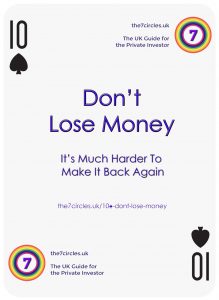10♠ – Don’t Lose Money
Don't Lose Money - It's Much Harder to Make it Back Again.
This post is part of the MoneyDeck series, a pack of 52 playing cards that describe 52 “golden rules” for Private Investors in the UK.
Don’t Lose Money – It’s Much Harder to Make it Back Again.
Today I’m going to try to convince you that one of the most important things in investing is to not lose money.
There aren’t many things that unite investors as diverse as Warren Buffett, Paul Tudor Jones, Seth Klarman and Mark Minervini.
- But they all say that it’s very important that you Don’t Lose Money.
Of course, they each mean something slightly different by it, and they each have different reasons for saying it.
- But they all say it.
Let’s find out why.
We’ll start with Buffett, since he’s responsible for popularising the phrase as part of his two rules:
- Don’t Lose Money.
- Don’t Forget Rule Number One.
So it’s the only rule, actually.
Buffet doesn’t mean it literally, of course – he’s lost lots of money on more than one occasion.
- He lost $23 bn in 2008.
What he means is make it as unlikely as possible that you will lose money.
- And if you do lose money, lose as little money as possible.
- Make sure that what you invest in has more potential upside than potential downside.
This means doing your own research (DYOR) and building in a Margin of Safety (Klarman, after Ben Graham).
- Don’t be frivolous or a gambler.
- Don’t invest because your friends or people you admire are investing.
- Don’t pay attention to whether you are investing with or against the crowd.
- Don’t buy what you don’t understand.
Buffett is also not talking about the temporary loss of paper money during stock market falls.
For Buffett, stock investing is like buying part of a company (and obviously, at his scale it really is buying part or all of a company), and of its future cash flows.
- So he’s interested in the long-term prospects of companies that could be run by idiots.
- He likes franchises and moats, and high profits and return on capital.
- He doesn’t like firms with a high risk of failure.
We can’t all invest like Buffett (and many of us would be temperamentally unsuited) – but we can get into that mindset.
Shorter term investors and traders like Jones and Minervini understand something else by the phrase.
They are talking about compounding, and how much it takes to get back to where you started.
- If you lose 50%, you need to make back 100% to get back to square one.
Much better to not lose the 50% in the first place – learn to Cut Your Losses.
- Not to mention the fact that losses hurt twice as much as the gains feel good.
So protecting your money is just as important as using it to make more.
- Which means that you have to use Stop Losses.
- And you have to learn about position sizing.
Linked to this is the idea of the Low Vol anomaly.
- Low volatility stocks (usually referred to as low risk stocks) outperform the market.
This goes against the Capital Asset Pricing Model (CAPM) which says that you need to take on extra risk to receive extra return.
The underlying mechanism for the Low Vol anomaly appears to be that low vol stocks dodge the bad years that would damage long-term compounding.
Trend following is another good way to protect yourself.
This is linked to the idea of switching between passive and active styles, which I talk about more below.
- Passive investing is great when there’s a bull market.
- But active is better when times are bad.
Trend-following (market timing based on moving averages) will keep you out of serious bear markets.
- It actually underperforms in bull markets, which seems to surprise a lot of people.
A final technique to avoid losses is the use of leveraged and derivative products (options, or in the UK, tax-advantaged spread betting).
- These products can obviously be used to increase your risk, as well.
- But used correctly they can offer most of the upside with limited downside.
Listed structured products operate in a similar space.
My own personal experience is that I’ve been investing now for thirty-five years, and I’ve only had one down year.
That was 2008, so I was in good company.
- And my Dad was dying, so I had a good reason for not giving my full attention to the markets.
My track record isn’t as good as it sounds.
- The default setting for UK private investors is a lot of UK stocks, and not much else.
Such a portfolio has had surprisingly few bad years during my career:
- 1987
- 2000 through 2002
- 2008
- 2015
I’ve dodged most of these for three reasons (apart from the general principles we mentioned above):
- switching between active and passive styles (active is better when markets are bad)
- switching between major asset classes (in my case, stocks and property)
- being in accumulation – it’s much harder to dodge declines in decumulation.
1987 was a bad crash (one of the worst), but it wasn’t such a bad year.
- I lost a lot of money in the final quarter and was too broke to buy presents that Xmas.
But it had been a good year until then, and the jobs market and wider economy were booming – as was the London property market.
- I was earning as much as I ever did in my life (whilst still in my twenties) and I had just bought my first house.
By 2000 I was an active trader, and I actually made money during the dot com crash, by getting out early.
- I then broke even in the markets for the next two years and piled most of my money into property once more.
2008 was the year that everything went down together.
- I wasn’t paying that much attention, but I’m not sure that there was much that I could have done.
- But at least I didn’t sell at the bottom.
I didn’t even notice 2015, so I’ll put that down to diversification.
- My home-made global benchmark returned 1.4%, dragged into positive territory by dividends and property.
- I made 5.3%, which I was very disappointed with.
As I write, 2018 is shaping up to be another bad year (apart from those heavily invested in the FAANGs), but I hope to scrape through and preserve my capital for better times.
I hope that I’ve convinced you to take the same approach.
Here are a few guidelines:
- Don’t throw away money with high platform and fund costs, or by paying too much in taxes – Costs Matter and Taxes Matter.
- Diversify, and actively switch between expensive and cheap assets – Asset Allocation Matters.
- Watch out for bubbles, and fashionable sectors and themes.
- Watch out for cons and scams, particularly if you getting on in years – if it looks too good to be true, it is.
- Turn off the noise.
- Have a system / process for buying and selling.
- Avoid firms with a lot of debt and those that have never generated positive cash flows.
- Don’t throw good money after bad, or catch a falling knife.
- Don’t sell at the bottom.
- Keep some cash (dry powder) so that you can (1) ride out a bear market and (2) pick up bargains after a crash.
- Protect yourself against all the future scenarios that you can imagine, as well as the “unknown unknowns” (Rumsfeld) and Black Swans (Taleb).
Some of this is easier said than done, but ignoring the problem is just planning for failure.
So remember, Don’t Lose Money – It’s Much Harder to Make it Back Again.
Until next time.


















Excellent article, thanks Mike